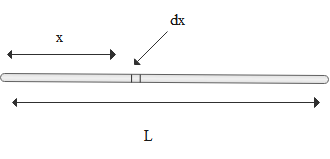
A rod of length L, having negligible thickness, has a linear mass density that varies from zero at one end to $\lambda$ at the other. Locate the centre of mass.
Answer
214.5k+ views
Hint: We should know that linear density is the measure of a quantity of any characteristic value per unit of length. Linear mass density and linear charge density or we can say the amount of electric charge per unit length are two common examples used in science and engineering. Linear mass density has the dimension mass per length. The SI composite unit of linear mass density is the kilogram per meter. Density can be inferred by knowing the relationship between mass and volume. For any given substance, there is a linear relationship between its mass and its volume: when one variable increases, the other variable increases, and vice versa. On the basis of this concept we have to answer this question.
Complete step by step answer
Let us first write the diagram:

As the rod is forming a linear expression it must be in the x-axis, so we can write that:
Hence, $\mathrm{Y}_{\mathrm{cm}}=0, \mathrm{Z}_{\mathrm{cm}}=0$
For coordinate
$\mathrm{x}_{\mathrm{cm}}=\dfrac{\int_{0}^{\mathrm{L}}
\mathrm{xdm}}{\int_{0}^{\mathrm{L}} \mathrm{L}} \mathrm{dm}=\lambda.
\mathrm{dx}=(\mathrm{A}+\mathrm{Bx}) \mathrm{dx}$
We can say this because the basic expression for any linear equation is $(A+Bx)$.
Hence, we can say that: $\lambda =(A+Bx)$
Therefore, on the integration of the expression we get:
$\mathrm{x}_{\mathrm{cm}}=\dfrac{\int_{0}^{\mathrm{L}}
\mathrm{x}(\mathrm{Ax}+\mathrm{B})
\mathrm{dx}}{\int_{0}^{\mathrm{L}}(\mathrm{A}+\mathrm{Bx})
\mathrm{dx}}=\dfrac{\mathrm{L}(3 \mathrm{A}+2 \mathrm{BL})}{3(2
\mathrm{A}+\mathrm{BL})}$
So, after the evaluation we get that $\left(\dfrac{\mathrm{L}(3 \mathrm{A}+2
\mathrm{BL})}{3(2 \mathrm{A}+\mathrm{BL})}, 0,0\right)$are the coordinates. Since it is
linear in nature, the x-axis equation will have y and z coordinates as zero.
Here coordinates of the centre of mass are $\left(\dfrac{\mathrm{L}(3 \mathrm{A}+2
\mathrm{BL})}{3(2 \mathrm{A}+\mathrm{BL})}, 0,0\right)$.
Note: We should know that the standard form for linear equations in two variables is $(Ax+By)=C$. There are three major forms of linear equations: point-slope form, standard form, and slope-intercept form.
Now to solve such questions it is required to have a knowledge of all the forms of equations. So, the descriptions are as follows. Point-slope is the general form $y-{{y}_{}}=m\left( x-{{x}_{}} \right)$for linear equations. It emphasizes the slope of the line and a point on the line (that is not the y-intercept). The standard form of linear equation is of the type $ax\text{ }+\text{ }by\text{ }=\text{ }c$, the x and y terms are on the left side of the equation and the constant is on the right side. The constant and both of the coefficients must be integers. And lastly, the slope-intercept form is of the kind.$y\text{ }=\text{ }m\text{ }x\text{ }+\text{ }b\text{ }y\text{ }=\text{ }mx\text{ }+\text{ }b\text{ }y=mx+b$.
Complete step by step answer
Let us first write the diagram:

As the rod is forming a linear expression it must be in the x-axis, so we can write that:
Hence, $\mathrm{Y}_{\mathrm{cm}}=0, \mathrm{Z}_{\mathrm{cm}}=0$
For coordinate
$\mathrm{x}_{\mathrm{cm}}=\dfrac{\int_{0}^{\mathrm{L}}
\mathrm{xdm}}{\int_{0}^{\mathrm{L}} \mathrm{L}} \mathrm{dm}=\lambda.
\mathrm{dx}=(\mathrm{A}+\mathrm{Bx}) \mathrm{dx}$
We can say this because the basic expression for any linear equation is $(A+Bx)$.
Hence, we can say that: $\lambda =(A+Bx)$
Therefore, on the integration of the expression we get:
$\mathrm{x}_{\mathrm{cm}}=\dfrac{\int_{0}^{\mathrm{L}}
\mathrm{x}(\mathrm{Ax}+\mathrm{B})
\mathrm{dx}}{\int_{0}^{\mathrm{L}}(\mathrm{A}+\mathrm{Bx})
\mathrm{dx}}=\dfrac{\mathrm{L}(3 \mathrm{A}+2 \mathrm{BL})}{3(2
\mathrm{A}+\mathrm{BL})}$
So, after the evaluation we get that $\left(\dfrac{\mathrm{L}(3 \mathrm{A}+2
\mathrm{BL})}{3(2 \mathrm{A}+\mathrm{BL})}, 0,0\right)$are the coordinates. Since it is
linear in nature, the x-axis equation will have y and z coordinates as zero.
Here coordinates of the centre of mass are $\left(\dfrac{\mathrm{L}(3 \mathrm{A}+2
\mathrm{BL})}{3(2 \mathrm{A}+\mathrm{BL})}, 0,0\right)$.
Note: We should know that the standard form for linear equations in two variables is $(Ax+By)=C$. There are three major forms of linear equations: point-slope form, standard form, and slope-intercept form.
Now to solve such questions it is required to have a knowledge of all the forms of equations. So, the descriptions are as follows. Point-slope is the general form $y-{{y}_{}}=m\left( x-{{x}_{}} \right)$for linear equations. It emphasizes the slope of the line and a point on the line (that is not the y-intercept). The standard form of linear equation is of the type $ax\text{ }+\text{ }by\text{ }=\text{ }c$, the x and y terms are on the left side of the equation and the constant is on the right side. The constant and both of the coefficients must be integers. And lastly, the slope-intercept form is of the kind.$y\text{ }=\text{ }m\text{ }x\text{ }+\text{ }b\text{ }y\text{ }=\text{ }mx\text{ }+\text{ }b\text{ }y=mx+b$.
Recently Updated Pages
Chemical Equation - Important Concepts and Tips for JEE

JEE Main 2022 (July 29th Shift 1) Chemistry Question Paper with Answer Key

Conduction, Transfer of Energy Important Concepts and Tips for JEE

JEE Analytical Method of Vector Addition Important Concepts and Tips

Atomic Size - Important Concepts and Tips for JEE

JEE Main 2022 (June 29th Shift 1) Maths Question Paper with Answer Key

Trending doubts
JEE Main 2026: Application Form Open, Exam Dates, Syllabus, Eligibility & Question Papers

JEE Main Correction Window 2026 Session 1 Dates Announced - Edit Form Details, Dates and Link

Equation of Trajectory in Projectile Motion: Derivation & Proof

JEE Main 2026 Application Login: Direct Link, Registration, Form Fill, and Steps

Hybridisation in Chemistry – Concept, Types & Applications

Angle of Deviation in a Prism – Formula, Diagram & Applications

Other Pages
JEE Advanced Marks vs Ranks 2025: Understanding Category-wise Qualifying Marks and Previous Year Cut-offs

Units And Measurements Class 11 Physics Chapter 1 CBSE Notes - 2025-26

NCERT Solutions For Class 11 Physics Chapter 8 Mechanical Properties Of Solids

Motion in a Straight Line Class 11 Physics Chapter 2 CBSE Notes - 2025-26

NCERT Solutions for Class 11 Physics Chapter 7 Gravitation 2025-26

Collision: Meaning, Types & Examples in Physics




